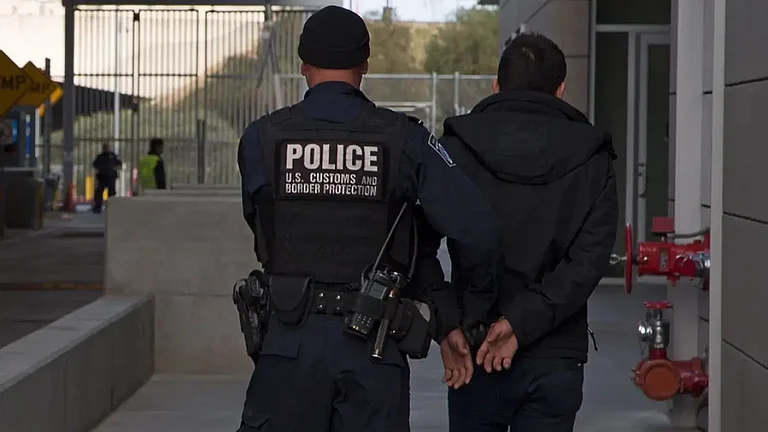The dominant understanding that the Covid-19 originated in nature —and could have only originated in nature— now stands seriously challenged with the latest revelations by US government agencies.
The US Department of Energy (DoE) has concluded that the Covid-19 pandemic most likely arose from a laboratory leak, reported The Wall Street Journal (WSJ). The report was followed by first on-the-record admission by the US Federal Bureau of Investigation (FBI) that it believes in the lab-origin of Covid-19.
These revelations have also coincided with US Congressional reports and email disclosures that show that top Western experts discussed lab-leak possibility privately but dismissed it publicly.
Now it’s understood that the conclusive evidence behind the artificial consensus on natural-origin of Covid-19 is the same as it was over three years ago in early 2020 — zilch. On the other hand, there is strong circumstantial evidence pointing to the possibility of a lab-leak.
To be sure, no credible voice advocating lab-origin investigation or assessing that Covid-19 originated in a lab says it was a biological weapon. They raise the possibility of a lab accident.
What do US DoE, FBI say on Covid-origin?
In light of the new evidence, the US Department of Energy (DoE) assesses that Covid-19 pandemic most likely arose from a lab leak, according to WSJ.
In 2021, US President Joe Biden tasked the US intelligence community (IC), comprising a total of 18 agencies, to come up with an assessment of Covid-origin. Only one of the 18 agencies —called “elements” of the IC— assessed the lab-origin. Four elements and the National Intelligence Council assessed natural-origin. Two others did not rule out that SARS-CoV-2, the virus that causes the Covid-19 disease, could have been bio-engineered, opening the possibility of lab-origin. Three elements could not come to any conclusion as the evidence with them was limited.
In that assessment submitted on White House in 2021, the DoE did not assess the lab-origin. The one agency that assessed lab-origin was later identified as the Federal Bureau of Investigation (FBI), but the agency never confirmed it — until last month.
Last month, FBI Director Christopher Wray admitted that the agency has concluded that Covid-19 pandemic began in the lab.
“The FBI has for quite some time now assessed that the origins of the pandemic are most likely a potential lab incident in Wuhan. Here you are talking about a potential leak from a Chinese government-controlled lab,” said Wray to Fox News in an interview.
Special expertise of DoE, FBI gives weight to assessments
These positions of DoE and FBI are important as these two agencies are best-equipped to investigate potential lab-origin and, more importantly in case of DoE, the assessment comes on the basis of new evidence and inputs.
“A senior US intelligence official confirmed that the intelligence community had conducted the update…This official added that it was done in light of new intelligence, further study of academic literature, and consultation with experts outside government,” reported WSJ.
The bit about new external consultation is particularly critical as it had earlier been flagged in a US Congressional report, which had noted that the IC was not forthcoming with responses to their pointed questions on this aspect. The report also said outside expert consultants were likely the reason why potential Chinese bio-engineering was downplayed in IC assessment.
“The Committee has reason to believe that the IC downplayed the possibility that SARS-CoV-2 was connected to China’s bio-weapons program based in part on input from outside experts…Despite numerous official requests, the IC has not disclosed to the Committee the identities of the consulted experts,” said the Minority Unclassified Summary of the Second Interim Report on the Origins of the Covid-19 Pandemic by House Permanent Select Committee on Intelligence.
The report indicated the possibility of these experts misleading the IC, saying, “Public reporting and information released by other Congressional committees have revealed that some prominent experts in these areas appear to have conflicts of interest stemming from grant arrangements and professional entanglements involved. Some even seem to have privately been asserting that the virus may have been engineered or the result of a lab leak while publicly discounting such views.”
The DoE employs thousands of scientists and oversees a network of laboratories dealing with nuclear, chemical, and biological research. Moreover, DoE’s expert investigators include a special ‘Division Z’ that has since the 1960s “been involved in secretive investigations of nuclear, chemical, and biological weapons threats by US adversaries, including China and Russia”, notes The Washington Post.
As for the FBI, it runs the foremost biosafety and anti-bioterrorism program in the United States, particularly after 9/11 attacks and the anthrax attacks that followed. The seriousness can be understood from the fact that biosafety is part of the FBI's weapons of mass destruction (WMD) program. Moreover, it runs a joint program with the US Centers for Disease Control and Prevention (CDC).
“The FBI and the CDC developed the Joint Criminal and Epidemiological Investigations training program to improve public health and law enforcement efforts to identify and investigate intentional or naturally occurring threats,” said Vahid Majidi, the then-Assistant Director, WMD Directorate at FBI in a statement 2011.
He further said, “In addition to being able to identify and investigate intentional or naturally occurring threats, a mission of the WMDD is to promote biosecurity…Pure sources of biological agents reside in biological supply companies/culture collection entities, research institutions, public health/health care laboratories, and industry. Safeguarding these dangerous biological materials is one key aspect of biosecurity.”
Spotlight on poor Chinese biosafety record
The basic idea behind a potential lab-origin of Covid-19 is that improper and unsafe handling of viruses, most likely during complex and experimental risky research, would have led to the leakage of the virus that then spread from person to person.
There are several examples of viruses leaking from labs and causing infections. The SARS virus escaped from labs multiple times in labs in 2003-04, multiple times in Beijing alone. Such leaks were rather frequent in China, with the latest taking place in 2019 months before the Covid-19 outbreak.
In their book VIRAL: The Search for the Origin of Covid-19, Alina Chan and Matt Ridley note that there is also a precedent for a pandemic beginning from a lab leak. The 1977 H1N1 pandemic is now understood to have originated in a laboratory from a vaccine trial gone wrong.
Molecular biologist Alina and veteran science writer Matt also note other lab-origin outbreaks in their book. In 2003, rats infected students in Kunming in China’s Yunnan province. In 2019, hundreds were infected by the release of live bacteria from a lab in Lanzhou in Gansu province. Notably, this happened months before the first known Covid-19 outbreak.
Citing published research and internal Chinese documents, a Congressional report noted biosafety failures and concerns in Chinese labs carrying out risky coronavirus research, including what’s called the gain of function (GoF) research. The Senate Committee on Health Education, Labor and Pensions (HELP) Minority Interim Report in October 2022 made the following observations:
- Wuhan Institute of Virology (WIV) patents and procurements suggest that the WIV experienced persistent biosafety problems relevant to the containment of an aerosolized respiratory virus like SARS-CoV-2.
- In May 2019, the Director of the WIV BSL-4 laboratory warned that in high-containment laboratories in China, maintenance costs were neglected and part-time researchers made it “difficult to identify and mitigate potential safety hazards in facility and equipment operation early enough”.
- Leadership at the WIV emphasised during a June 2019 meeting with WIV officials that addressing the “stranglehold problem” was critical to “pushing forward the construction and…development of science and technology for the nation”.
- In July 2019, the deputy director of the BSL-4 laboratory issued a report on shortages of biosafety equipment and its impact on meeting the research expectations of the government.
- A November 12, 2019 report suggested a biosafety problem had occurred at the WIV sometime before November 2019.
- On November 19, 2019, the WIV hosted a special training session by the senior Chinese Academy of Sciences biosafety/biosecurity official who relayed “important oral and written instructions” from PRC leadership to the WIV regarding the “complex and grave situation facing [bio]security work”. This one-day training session for senior leadership was followed on November 20-21, 2019 with two days of safety training for personnel from the WIV and other Wuhan area high containment laboratories.
Not just in China, which is fundamentally opaque because of the nature of its state structure, biosafety and transparency concerns have also been raised with regard to open democracies like India and the United States. At the centre of biosafety concerns is a particular kind of risky work called ‘gain of function’ research that was long advocated as being essential to prevent the next pandemic.
What's the gain of function research, is it worth it?
The gain of function (GoF) research can be any research that gives new properties to an organism —such as a virus— that it does not naturally have. However, it has come to be associated with scientific activities where organisms’ transmissibility or virality is enhanced in a lab. It’s often more formally called enhanced pandemic potential pathogen research.
The advocates of GoF research say it’s required to understand how a virus could evolve and infect humans in new ways. The promise has for decades been that it would help us to prepare for the next pandemic by understanding how a virus could cause it. Now that we know that GoF research didn’t prevent Covid-19 pandemic, the question is that could it have caused it instead? Moreover, there is a more fundamental question — do we need GoF research? Do potential benefits outweigh the risks of hotwiring viruses in labs?
The GoF research has become central to the lab-origin hypothesis of Covid-19. It’s backed by the fact that Covid-19 emerged next door to the world’s leading coronavirus research institution that was also the global hub of coronavirus GoF research — the Wuhan Institute of Virology (WIV). In partnership with US experts and under sponsorship of US sub-grants, WIV’s Shi Zhengli, carried out research on coronaviruses for years.
With US-based EcoHealth Alliance’s Peter Daszak, Shi collected 630 types of coronaviruses during 2010-15, often travelling to remote caves and mines. She also collaborated with US-based Ralph Baric, a GoF specialist.
In the 1990s, Baric and Boyd Yount of the University of North Carolina "trained" a mice coronavirus to infect hamsters. In 2006, Baric patented a technique through which a virus could be modified “invisibly” — meaning it would leave no trace that it has been edited. In 2015, Baric collaborated with WIV’s Shi. They published a paper in which they showed that they fused a bat coronavirus and a human coronavirus and showed that the resultant virus could infect mice as well as humans.
Now that the basic premise of preventing the pandemic stands shattered, as decades of GoF research could not prevent Covid-19 pandemic, its very relevance is under question.
“The risks are far greater than the potential benefits, as I have shown in my research. Much of GoF is conducted under the premise of ‘preventing a pandemic’ but how does seeking out remote animal viruses, far from human habitation, and bringing them into labs to study them and do GoF on them help? To date such research has failed to provide tangible benefits, but the risks are substantial,” says Raina MacIntyre, NHMRC Principal Research Fellow and Professor of Global Biosecurity at University of New South Wales (UNSW), Australia.
Molecular biologist and VIRAL co-author Alina spoke on similar lines, highlighting that GoF research on coronaviruses had zero utility in Covid-19 pandemic.
“When the pandemic began, the Wuhan researchers who had been hunting novel coronaviruses refused to share their virus database and their US collaborator even said there was nothing relevant in their database. The vaccines and therapeutics in this pandemic were developed without having to use any of the novel viruses these scientists had found and experimented with,” said Alina, Scientific Advisor at the Broad Institute of MIT and Harvard, to Outlook in an earlier interview.
MacIntyre further says that GoF research can have a role in some instances but much of it is unnecessary and poses “undue risk for humanity”.
She tells Outlook, “It should be done under stricter regulation and in fewer sites, with better processes for biosafety. To date the major consideration has been the rights of scientists to have freedom to do GoF. We need to have the community voice at the table. We need to inform the community and engage with them, and consider the rights of the community, who are the ultimate stakeholder in benefits and risks of such research.”
MacIntyre says the current regulatory and oversight mechanism regarding GoF research is not sufficient and we need “global, consistent and enforceable governance”. She says GoF research should be as transparent and publicly disclosed as any clinical trial.
She tells Outlook, “Such research should be registered on a public register just as clinical trials are. The latter was a major change that came about around 2008, when granting bodies, funding agencies, journals, all came together to ensure no clinical trial could be funded or published unless it was registered in a public register. This was to stop companies hiding the results of unfavourable trials. At the time, it seemed impossible but every part of the scientific community came together to create this change in research culture and practice. I believe it is possible for GoF too, but the vested interests of scientists will be a bigger barrier to such change.”
Harish Seshadri of biosafety collective BiosafetyNow also noted that there is a great deal of opacity around GoF research. He highlights that there is no international repository —publicly accessible or not— of risky research projects on pandemic pathogens taking place across the globe. He also expressed concerns about the expansion of BSL-3 and -4 labs — the highest biosafety level labs used for riskiest research.
“In India, as in the United States, BSL-3 and -4 labs are largely autonomous. Advocating for strict oversight and regulation of these labs is the prime objective of our NGO BiosafetyNow,” says Seshadri, Professor of Mathematics at Indian Institute of Science, Bengaluru.
However, Seshadri adds that there is one positive in the Indian set-up which is not there in the United States. He notes that the riskiest research in India has to be approved by the federal government regulator.
He tells Outlook, “From what I understand, the Indian structure is very similar to that of the USA. Institutional Biosafety Committees (IBSCs) play a crucial role in biosafety compliance and approval of projects. These are set up by the institute where the lab is located. The interesting positive difference is that more risky work —what they call RG/4— has to be further approved by the national body called Review Committee on Genetic Manipulation (RCGM). In short, there does seem to be oversight and the government website is supposed to have a list of ongoing projects.”
He adds, “However, what appears to be missing is a central authority that will ensure compliance with biosafety rules. Leaving this serious matter to IBSCs will lead to non-uniform standards across the country. Incidentally, the US might establish such a federal agency in the near future.”
While the chapter of Covid-origin is far from conclusion or closure, an increasing body of independent experts now call for a robust investigation of potential lab-origin. At the centre is GoF research that —as Alina and MacIntyre say— has failed to serve its stated purpose. It’s not that questions are being raised for the first time. They date to the time of former US President Barack Obama, noted Robert E Moffit, Senior Research Fellow, Center for Health and Welfare Policy, Heritage Foundation.
He tells Outlook, “It is obvious, of course, that genetically altering a pathogen to enhance its transmissibility or lethality is extremely dangerous. That is why the Obama administration imposed a moratorium on such research in 2014. That is also why former CDC Director Dr Robert Redfield, a virologist by training, recently testifying before the Congress, also supports a moratorium.”
As public experts and activists continue to scrutinise GoF research at Wuhan and elsewhere, and await more information to be released by the US government on the question of Covid-origin, one thing is certain — the spotlight shall remain on risky scientific research that has gone unsupervised for a very long time.


























